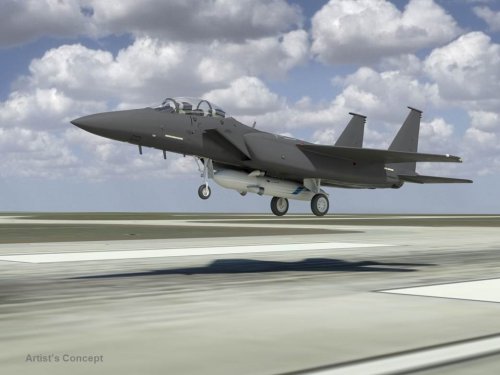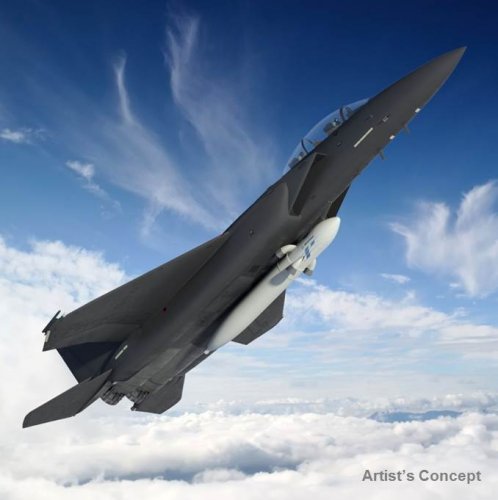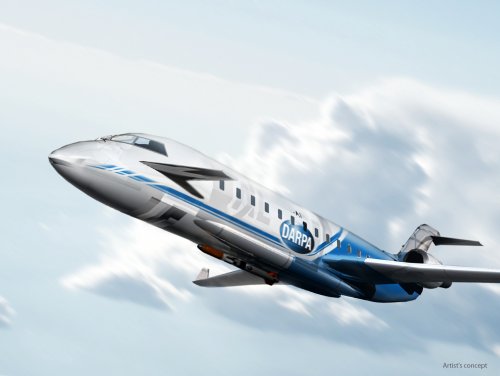You are using an out of date browser. It may not display this or other websites correctly.
You should upgrade or use an alternative browser.
You should upgrade or use an alternative browser.
Airborne Launch Assist Space Access Program (ALASA)
- Thread starter sferrin
- Start date
- Joined
- 9 November 2008
- Messages
- 1,070
- Reaction score
- 137
I did not see this in the vid, but here is why it has the engines mounted in the front
http://www.thespacereview.com/article/2543/1
While SALVO is an operational testbed for ALASA, it will use different launch technologies. Boeing plans to take a unique approach with the ALASA launch vehicle that is also intended to lower complexity and thus costs. The rocket will be powered by a monopropellant: a combination of nitrous oxide and acetelyene, mixed together in the same propellant tank and “slightly chilled” below room temperature, Clapp said. That propellant choice offers simplicity as well as a specific impluse “not far off” from LOX and RP-1. “That’s kind of a big deal,” he said. “In general, it’s a dramatic simplification of the complexity of a rocket vehicle.”
The rocket’s design is also unusual, mounting four engines just below the payload on the vehicle. The engines are used for the first and second stages of the rocket, with propellant tanks below the engines dropping away when exhausted. This approach avoids the expense and complexity of separate sets of engines for the first two stages
http://www.thespacereview.com/article/2543/1
bring_it_on
I really should change my personal text
- Joined
- 4 July 2013
- Messages
- 3,123
- Reaction score
- 2,238
A different approach to what Dassault had planned
https://www.youtube.com/watch?v=XpiR0SqdUPM
I also like NASA's Towed Glider Air-Launch System (TGAL) concept.
https://gcd.larc.nasa.gov/wp-content/uploads/2015/01/FS_TGLAS_150129.pdf
https://www.youtube.com/watch?v=05_1BL68XzQ
https://www.youtube.com/watch?v=XpiR0SqdUPM
I also like NASA's Towed Glider Air-Launch System (TGAL) concept.
https://gcd.larc.nasa.gov/wp-content/uploads/2015/01/FS_TGLAS_150129.pdf
https://www.youtube.com/watch?v=05_1BL68XzQ
- Joined
- 3 June 2006
- Messages
- 2,841
- Reaction score
- 2,534
http://www.darpa.mil/Our_Work/TTO/Programs/Airborne_Launch_Assist_Space_Access_(ALASA).aspx
http://www.darpa.mil/NewsEvents/Releases/2011/11/10.aspx
Older concepts using Bizjets and a Boeing 747 as launch platform:
http://www.citizensinspace.org/2012/04/airborne-launch-assist-space-access/
http://www.darpa.mil/NewsEvents/Releases/2011/11/10.aspx
Older concepts using Bizjets and a Boeing 747 as launch platform:
http://www.citizensinspace.org/2012/04/airborne-launch-assist-space-access/
Attachments
- Joined
- 16 April 2008
- Messages
- 8,387
- Reaction score
- 10,304
I'm not understanding something in the video. The text descriptions talk about using the same motors for the first and second stages, but the video shows at least the nozzles being jettisoned with the first stage. The second stage seems to have separate nozzles and doesn't seem to use the same motors at all. At least I can't see how the two nozzles could work with one motor. Am I missing something?
- Joined
- 9 November 2008
- Messages
- 1,070
- Reaction score
- 137
That's what I was confused about too.
It made sense to have the nozzles forward if they were to be reused but tossing them with the 1st stage seems to violate the KISS principle.
Maybe someone forgot to tell the animators?
It made sense to have the nozzles forward if they were to be reused but tossing them with the 1st stage seems to violate the KISS principle.
Maybe someone forgot to tell the animators?
What is the separation altitude and velocity? I just cant see that being cheaper than a solid rocket 1st stage. MAYBE for a private jet, it would be cheaper than an F15, but that private jet isn't going to get near the altitude and velocity of that F-15.....
Didn't the Navy just say their railgun would hit satellites? A bigger railgun for launching satellites would make more sense than this.....
Didn't the Navy just say their railgun would hit satellites? A bigger railgun for launching satellites would make more sense than this.....
bring_it_on
I really should change my personal text
- Joined
- 4 July 2013
- Messages
- 3,123
- Reaction score
- 2,238
sublight is back said:What is the separation altitude and velocity? I just cant see that being cheaper than a solid rocket 1st stage. MAYBE for a private jet, it would be cheaper than an F15, but that private jet isn't going to get near the altitude and velocity of that F-15.....
Didn't the Navy just say their railgun would hit satellites? A bigger railgun for launching satellites would make more sense than this.....
http://www.secretprojects.co.uk/forum/index.php/topic,23452.msg241120.html#msg241120
- Joined
- 16 April 2008
- Messages
- 8,387
- Reaction score
- 10,304
sublight is back said:What is the separation altitude and velocity? I just cant see that being cheaper than a solid rocket 1st stage. MAYBE for a private jet, it would be cheaper than an F15, but that private jet isn't going to get near the altitude and velocity of that F-15.....
Didn't the Navy just say their railgun would hit satellites? A bigger railgun for launching satellites would make more sense than this.....
The launch acceleration for a railgun would be heroic (1000g or more). The means an incredibly hardened payload. This is a soft launch, at least by comparison.
TomS said:The launch acceleration for a railgun would be heroic (1000g or more). The means an incredibly hardened payload.
Cannon-launched laser and GPS guided munitions often get to 20,000 G's, if memory serves. If your goal is to whack a satellite... if you have a cannon that can actually reach up that far, then the payload designers will give you a guided kill vehicle.
RadicalDisconnect
Anthony Foulke
- Joined
- 28 April 2014
- Messages
- 163
- Reaction score
- 6
A friend of mine over at UCLA said that they had some thought about this method as an option of putting their ELFIN CubeSat into space. Not sure if our own UCISAT will look into it.
- Joined
- 16 April 2008
- Messages
- 8,387
- Reaction score
- 10,304
Orionblamblam said:TomS said:The launch acceleration for a railgun would be heroic (1000g or more). The means an incredibly hardened payload.
Cannon-launched laser and GPS guided munitions often get to 20,000 G's, if memory serves. If your goal is to whack a satellite... if you have a cannon that can actually reach up that far, then the payload designers will give you a guided kill vehicle.
Yes, they do. But I'm taking about the problems of using railguns as a space launch solution, not an ASAT system. Of course you can harden payloads to work with those accelerations, but it is a lot easier to do for a kill vehicle that only has to work for a couple of minutes than a satellite that needs to work for weeks or months. DARPA wants to use ALASA to launch a constellation of 1-m imaging small sats. Hardening those for a railgun launch would be pretty tough.
bring_it_on
I really should change my personal text
- Joined
- 4 July 2013
- Messages
- 3,123
- Reaction score
- 2,238
For a Railgun launch you are dealing with up to 100K Gee Acceleration. Thats definitely outside of this program when you are trying to launch a satellite that weights less then 100 Kg.
- Joined
- 21 April 2009
- Messages
- 13,161
- Reaction score
- 6,029
Fighter Space Launch Nearing Test Flight
2/9/2015
DARPA plans to test-fly a prototype F-15-carried rapid and affordable light weight satellite launch vehicle later this year, and potentially blast a test vehicle into orbit as early as 2016, officials announced. "We’ve made good progress so far toward [Airborne Launch Assisted Space Access'] ambitious goal of propelling 100-pound satellites into low Earth orbit (LEO) within 24 hours of call-up, all for less than $1 million per launch," said Bradford Tousley, DARPA tactical technology director. DARPA worked with Lockheed Martin Skunk Works to mature the technology, and awarded Boeing a contract to design and build up to 12 test articles. Pending the success of a new liquid monopropellant fuel being developed for the booster, DARPA plans to launch an ALASA prototype into space in the "first half of 2016," according to the Feb. 5 release. Depending on the result, DARPA plans to launch 11 more test-shots in the summer of 2016.
----------------------------------------------------------
See bolded is that correct 11 test-shots in 2016? Also (my opinion) would this make a good air launched strike missile, what size warhead could it carry if it only had to go 500km or so?
2/9/2015
DARPA plans to test-fly a prototype F-15-carried rapid and affordable light weight satellite launch vehicle later this year, and potentially blast a test vehicle into orbit as early as 2016, officials announced. "We’ve made good progress so far toward [Airborne Launch Assisted Space Access'] ambitious goal of propelling 100-pound satellites into low Earth orbit (LEO) within 24 hours of call-up, all for less than $1 million per launch," said Bradford Tousley, DARPA tactical technology director. DARPA worked with Lockheed Martin Skunk Works to mature the technology, and awarded Boeing a contract to design and build up to 12 test articles. Pending the success of a new liquid monopropellant fuel being developed for the booster, DARPA plans to launch an ALASA prototype into space in the "first half of 2016," according to the Feb. 5 release. Depending on the result, DARPA plans to launch 11 more test-shots in the summer of 2016.
----------------------------------------------------------
See bolded is that correct 11 test-shots in 2016? Also (my opinion) would this make a good air launched strike missile, what size warhead could it carry if it only had to go 500km or so?
- Joined
- 16 April 2008
- Messages
- 8,387
- Reaction score
- 10,304
And the flight tests are cancelled. Seems the test articles developed a bad habit of blowing up thanks to get nasty propellant combo selected.
http://spacenews.com/darpa-airborne-launcher-effort-falters/
They're still doing some work with the propellant but it looks like the overall ASALA is dead, at least for the moment.
http://spacenews.com/darpa-airborne-launcher-effort-falters/
They're still doing some work with the propellant but it looks like the overall ASALA is dead, at least for the moment.
Similar threads
-
Masten Space Systems' suborbital vehicles
- Started by FutureSpaceTourist
- Replies: 18
-
Absolutely mindblowing video shot from the Space Shuttle during launch (io9)
- Started by Grey Havoc
- Replies: 5
-
-
South Korea successfully conducts third test flight of solid-fuel space rocket
- Started by Flyaway
- Replies: 0
-
GQM-163A Coyote Target Missile
- Started by fredymac
- Replies: 85



